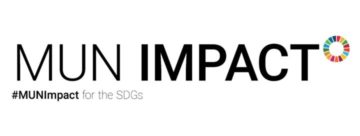On the final day of the Global Summit, three rising seniors at John Burroughs School in St. Louis, Mo presented their project End Period Poverty to 30 participants. Katherine Holkamp, Kate Smith, and Nathaniel Doty are leaders of the Gender Equity Organization at their school, frequent MUN conference attendees, and leaders of the MUN IMpact club at their school.
The presenters began with an introduction to what period Poverty is. Explaining how periods cannot be ignored, and are not a choice, yet the costs are enormous and 60% of women in developing countries lack access to menstrual hygiene products. This statistic can have lasting medical repercussions. They made sure to highlight that even in developed countries on average women are spending $18,000 on period supplies throughout their life. An enormous cost to a necessity.
Presenters highlighted specific cases where period stigma is high. For example, in Nepal, menstruation women are isolated in mud huts with no access to running water and clean supplies. They talked about Ethiopia where women often skip school or even drop out of school when they get their period due to lack of access to a bathroom and to avoid embarrassment at school. And talked about the luxury tax in the UNited States, driving the prices up and leaving many girls without access to supplies.
This discussion led into End Period Poverty’s first step: destigmatizing periods. Holekamp highlighted how End Period poverty connects to 7 SDG’s and 17 subsections of the SDGs including SDG 1 no poverty, SDG 4 Quality Education, SDG 6 Clean Water and Sanitation.
Doty went on to stress how “when there is any discrimiation against women, it will hurt the wellbeing of our society as a whole.” But urged the participants that there is hope and shared projects and organizations working towards improving these conditions and stigma in their own communities.
The three presenters dove into their process of creating their own Period Supply Drive and increasing awareness in their own school. Smith emphasized their 4 main goals
- Increase awareness, decrease stigma
- Advocate for women and girls, especially those prevented from reaching their potential by period poverty
- Provide menstrual products to all women and girls affected by period poverty.
- Search for long-term sustainable solutions to period poverty.
Their solutions: frequent announcements at their all school assemblies, hanging posters in their school, bringing males in their school to buy products, organizing a drive in the school community, and partnering with associations in their city such as The Women’s Safe House and donating the products there.
This group then turned to encourage others to take action. To pick an idea and jump on it. Take Action! Combine Service work, activism, and donations and use MUN connects and resources to make an impact.
During the question and answer section it was clear these three presenters had encouraged the participants to start their own drives and initiatives. The questions focused on how to get your school on board with something like this, how to take their first steps, how to get male peers on board, and more.
The group then split up into breakout groups. To get smaller conversations going and more participation for the students. In one breakout session, the group talked about how period poverty is apparent in their own schools and communities. Students shared their stories of their school pushing back against articles in their school newspaper about periods, embarrassment and secrecy about periods, and more.
